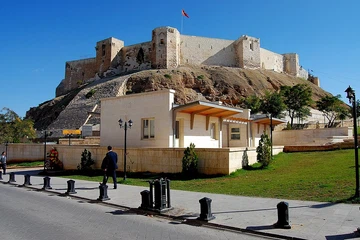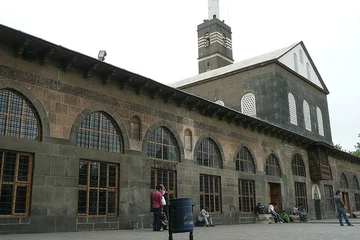Diyarbakır, where you can make a full travel plan with the Diyarbakır travel guide, has a history dating back 9 thousand years and has served as a bridge between Anatolia and Mesopotamia for centuries. People living in the region; It has carried the cultural and historical heritage from the Hurrian, Assyrian, Urartu, Scythian, Medpersan, Akkoyunlu, Macedonian, Roman, Sassanid, Byzantine, Seljuk, Umayyad, Artuqid, Ayyubid, Mongolian, Safavid and Ottoman states to the present day.
Diyarbakır is the largest city in Southeastern Anatolia with a population of 1 million 500,000. The city, which constantly receives immigrants, has grown rapidly. The tiger defeated the city, and Diyarbakir Castle, one of the largest walls in the world, is one of the most important symbols of the city. Also in the city are the Ulu Mosque, Behram Pasha Mosque, Hz. Ömer, Mesudiye Madrasa. You can visit places such as Virgin Mary Church and Atatürk House. You can also go to Diyarbakır Castle, one of the largest surviving castles in the world after the Great Wall of China.
Diyarbakir is affected by the continental climate. Summers are very hot and dry, but winters are not as cold as in Eastern Anatolia. The airport is close to the city center. 6 km. You can reach the city center from the remote airport by bus and taxi. In Diyarbakır, which has a rich culinary culture, you can eat stuffed ribs, stuffed meatballs, liver kebab and stuffed kadayıf. If you are thinking of planning a trip to this city; Be sure to review the details of our Diyarbakir travel guide article.
Diyarbakir Grand Mosque
MarTama Church, the largest Christian church in the city center, was converted into a mosque by the Muslim Arabs of Diyarbakır province during the reign of Ömer in 639 AD. It was restored by the Great Seljuk ruler Melikşah in 1091. The mosque, which was later severely damaged in the earthquake and fire of 1115, was repaired in 1240 with support from the people's homes.
Hazrat Suleiman Mosque
One of the historical mosques in Sur district of Diyarbakır. Süleyman Mosque was built by Nisanoğlu Ebul Kasım in 1155-1160. The building, also known as Nasiriye Kale Mosque and Murtaza Pasha Mosque, has a Seljuk plan and Arab influences in its architecture. Between 1631 and 1633, the mosque and the adjacent Mashhad section were restored by Silahtar Governor Murtaza Pasha. The sanctuary, fountain and tomb in the west of the mosque are among the prominent ones. There is also a tomb and a fountain in the northern part of the mosque.
Ziya Gökalp Museum House
The two-storey building, built from basalt in 1806, is the house where sociologist Ziya Gökalp was born in 1876. Ziya Gökalp's family moved to this house in 1824, and after his death, it was converted into a museum by the Ministry of Tourism in 1956 upon request. The house containing the belongings and documents of the famous writer; Diyarbakir is visited by many people with flight tickets.
All rooms in the house are located around the courtyard. You can see beautiful examples of iwan pools in Diyarbakır houses. The museum, which hosts thousands of tourists every year, is built based on the houses of the Diyarbakır ethnic group.
Hevsel Gardens
It still maintains its existence in the region it created by specifically responding to the production and cultural needs of all civilizations living in the region. The cultural landscape of Diyarbakır Castle and Hevsel Garden consists of two main parts, the city walls and the orchard, and together with the gardens of the seven thousand year old Diyarbakır Castle, it is an important heritage site for history. Diyarbakır, where garden culture is very important, has been open to the public for many years as a unique value as a residential garden. Diyarbakır Castle and Hevsel Gardens were included in the UNESCO World Cultural Heritage List in 2015. You can easily reach this point by looking at Diyarbakir flight ticket deals.
Behram Pasha Mansion
Behram Pasha's residence, one of the best examples of civil architecture in the region, was divided into two parts, east and south, and was built as two floors. Basalt was used in its construction and consists of an inner courtyard, an iwan and rooms surrounding the courtyard.
Gazi Mansion Oriental House
Gazi Mansion, also known as Seman Mansion, was built in the 15th century and bears the traces of Akkoyunlu architecture. After the Battle of Gallipoli, Atatürk was appointed to the Eastern Front and Diyarbakır as the Commander of the 16th Army in 1916. From that day on, Atatürk stayed here until 1917. You can see this place more closely with your Diyarbakır bus ticket.
Cemil Pasha Mansion
Cemil Pasha residence was built in 1887 and is one of the examples of civil architecture in Diyarbakır. It is divided into two parts, the harem and greetings, with a large courtyard and the buildings surrounding it. With its eye-catching architecture, it has become one of the historical places that use limestone and cut stone. It can be said that the villa, which has two entrances, is quite large. It also has a garden with a swimming pool and a cottage. The rooms are divided into summer and winter, giving visitors a pleasant feeling when using the guesthouse and other private rooms. In the mansion, which was repaired in 2014; many objects such as textiles, ceramics, glass, metal; Visit to Diyarbakir with bus ticket waiting for its workers.
Diyarbakir Archeology Museum
Opened in 1934, Diyarbakır Archeology Museum moved to its new building in 1986 and continues to host its visitors here. During this deportation, he continued to serve in the Sinjariye Madrasa, which was built by the ruler Artuqid al-Melikü during the reign of Salih Mahmud, to the west of the Ulu Mosque. In the museum; In the museum, where Hittite, Assyrian, Roman, Byzantine, Artuklu, Akkoyunlu and Ottoman artifacts from Diyarbakır and its surroundings are exhibited, Neolithic artifacts obtained from the region are also exhibited. The total number of works in the museum exceeds 11 thousand.
Park Forest
This park, also known as Ayşe Nur Parkorman, meets the oxygen needs of Diyarbakır and was opened to public use in 2007. There are a total of 1553 trees, dwarf trees and shrubs in the park, 11,000 of which are of 57 different species. There is a 900 meter pedestrian park, a 250 meter bodhi tree avenue, a 160 meter ash tree path, a 110 meter rosary path and a 90 meter long plane tree path.
Monument Park
The park, which was previously neglected and covered with the tea gardens of two families, was transformed into a clean one with the work carried out by Yenişehir Municipality and opened to public use. In the park; Walking paths and playgrounds for pedestrians are also decorated with ornamental pools. The Ataturk monument is located in the middle of the park and special days and weeks are celebrated here. If you are thinking about where to visit in Diyarbakır, you should definitely include this place in your travel plan.
Mount Zulkuf
Zülküf Mountain, considered sacred by the Ergani people, is divided into two separate parts. One of them is Hz. Zülküf's mausoleum and the other one is the Virgin Mary Church. It is said that the funeral of Prophet Zulkuf is in Egil, but he has a seat on the mountain. The region, which is very popular among the public, also attracts great interest from surrounding provinces. When they come to Zülküf Mountain, which is visited more in the spring, they often visit this place, bringing food and praying. While the Holy Quran and Mevlids are recited, wishes are made, vows and sacrifices are made.
Hasuni Caves
One of the most common answers to the question of where to visit in Diyarbakir is undoubtedly; Hasuni Cave. Hasuni Cave, 7 km away from Silvan, was used as a settlement in the Mesolithic age and is known as the oldest residential cave in Anatolia. It was one of the settlements in the Ancient and Middle Ages, in the early days when Christianity spread. In addition to architectural works that will meet the cultural and social needs of the settlement, such as roads, stairs, aqueducts, stone churches, cisterns and weaving factories, a medieval church was also built.
Tigris River
The stream that originates at the intersection of Kara Stream and Aktoprak Stream in Akçayurt village of Diyarbakır is called Tigris River. The life of the Tigris, one of the two rivers that make up Mesopotamia, which has seen many wars throughout history, ends in the Persian Gulf. The river, which is the source of life in the Middle East, is undoubtedly a very important river in Turkey as well. It stops in the provinces of Elazığ, Diyarbakır, Batman and Mardin, moves towards the Turkey-Syria border and passes through Iraq at the point where the Turkey-Iraq-Syria border triangle is located. You should definitely visit this river, which is a must among Diyarbakır tourist attractions.
Çermik Thermal Springs
Çermik Thermal Springs, located in Çermik district of Diyarbakır, is known to be good for skin diseases, paralysis and rheumatic diseases. Likewise, the Belkıs Bath located here mainly hosts women who want to have children. Women who wash with a special prayer they recite believe that they will have children. Çermik hot springs; It has been tested by the Ministry of Health and has elemental sulfur and thermal water radiation quality. Its most important feature is the presence of bromide and iodide ions in water.
Malabadi Bridge
Lastly among Diyarbakir tourist attractions; Malabadi bridge. Silvan Malabadi Bridge, one of the historical treasures of Diyarbakır, was built in 1147 during the Artukid period. The bridge, which is one of the most important architectural and engineering masterpieces reflecting the Seljuk period, stands out as the world's longest arched stone bridge with a pointed main arch.


